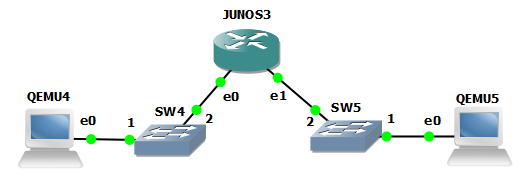Virtual Juniper`s Mythbusters: Policies & Filters

I begin a series of mini articles about the destruction of the legends associated with Juniper JunOS virtualizations on a PC.
Myth one: “Policer Filters (interfaces don't measure realtime traffic rates)”, this statement can be found on one of the most authoritative unofficial Juniper Olive websites.
The essence of the legend is that the Policer Filters do not work correctly, the interfaces measure traffic in real time incorrectly.
')
For the test, we use a fairly productive system based on the Intel Core i7 processor, with 8 Gb of RAM and the Windows 7 (x64) operating system.
The latest version of GNS3 was also used (with applications included in its composition, such as modified qemu), the accelerator was also used - kqemu.
Juniper Virtual JunOS 10.4 M / T Series acted as the router, debian lenny clients. For the router, 512 Mb of RAM and 128 are allocated for each client, respectively. The total load on the CPU of the system did not exceed 0.27.
Tools for generating and receiving information about Iperf traffic.
Under the cut enough screen shots.
The following configuration was assembled on the test bench:

For testing we used several configurations, let's stop on this:

When testing without filtering on interfaces, an average bandwidth of 47.8Mbit / s was obtained. (screenshots could not attach, for the reason that I forgot to save them).
Iperf parameters are similar to testing with filter and are listed below:


Next, I suggest that you heed screenshots of test results with different values for the constraint:




Conclusion

In the next series - VLANs ...
Source: https://habr.com/ru/post/112390/
All Articles